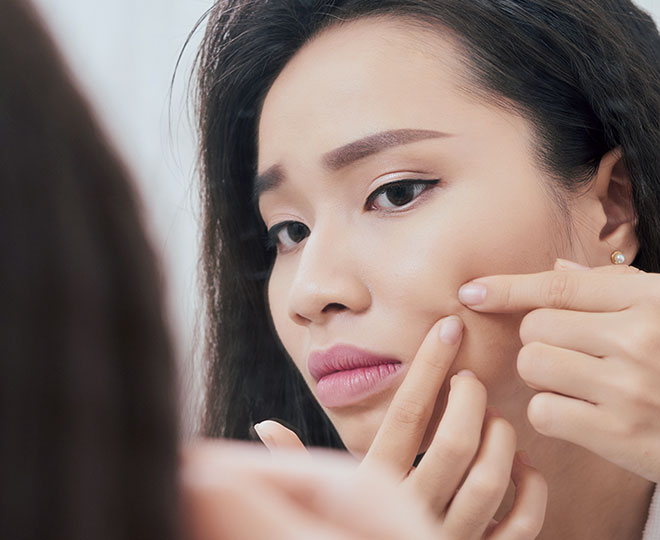Acne on cheeks can be a pain to deal with, especially when you’ve got a big event approaching and find yourself combing through online forum after online forum for every fast-acting zit remedy imaginable. However, as tempting as it may be to reach for some makeup, concealing acne on cheeks with layers of concealer and foundation is probably not your best course of action ‒ this can clog pores, and as a result, cause more breakouts to form. Sigh.
But not all hope is lost, as how to get rid of cheek acne truly extends to actually identifying its causes, including all the sneaky ones you would never suspect. That being said, to help you understand how to prevent acne on cheeks, below are some common cheek acne causes, easy swaps and fixes to remedy the problem, tips on how to identify cheek acne, and more.
But first, let’s start by explaining the differences between cheek acne and rosacea.
Cheek acne vs rosacea
Much like acne, rosacea is a skin condition that causes redness to appear in the facial area. However, it's important to remember that there are key differences between the two. Unlike rosacea breakouts, redness usually only surrounds pimples. Rosacea causes redness to appear on several facial areas including the cheeks, forehead, nose, and chin.
And yes, it is possible for acne and rosacea to occur at the same time. That being said, if you are having difficulty determining if you have acne, rosacea, or both on your hands, it’s best to consult with a board-certified dermatologist to assess and address your skin concerns.
What causes cheek acne
Here are some possible causes of cheek acne that you might not have considered.
-
Dirty pillowcases, sheets, and cellphones
Acne occurs when pores become clogged with excess dead skin cells, dirt, and sebum. However, the surfaces and items we come into contact with can trigger breakouts ‒ especially since they too can collect dead skin cells and sebum.
Pillowcases and bedding items, for example, can collect dirt, oil, and acne-causing bacteria, which, in return, can clog pores, and, therefore, trigger breakouts. To prevent your pillowcase and bedding items from causing breakouts, be sure to change and clean them regularly, (ideally once a week.)
Like pillowcases, cellphones can also cause breakouts, as they collect bacteria that gets passed by touch onto your cheek, making it important to clean your phone regularly as well.
-
Touching your face
As your fingers can have dirt, bacteria, and sebum on them, touching your face with unclean hands can spread the contaminants from your hands into your pores on cheeks. To prevent future breakouts from occurring, always wash your hands before touching or applying cosmetics to your face.
-
Skincare
Believe it or not, getting rid of cheek acne also extends to switching to non-comedogenic products. A lot of cosmetic products, like makeup, hair, and skincare, that we use on a daily basis can contain oil, which can clog pores and cause breakouts. To stop cheek breakouts in their tracks, try switching to oil-free or non-comedogenic products.
-
Improper shaving technique
While shaving doesn’t cause acne, it can irritate your skin and even lead to folliculitis, which can look a lot like a sudden acne breakout. Remember to ask your doctor if you think you may have folliculitis.
-
Hormonal changes
Hormonal changes can also influence your breakouts on cheeks. But while it’s easy to assume that these hormonal changes are limited to puberty and your teenage years, adult acne can affect adults at almost any age. In general, women, pregnant women, and women going through menopause have a higher risk of developing it.
Because hormonal acne can vary in severity, it’s best to consult with a dermatologist if you develop severe acne. These brilliant individuals can prescribe topical treatments and oral medications that can help your acne clear.
The bottom line
While acne on your cheeks may be annoying to deal with, thankfully, there are fixes to help prevent these breakouts from coming back.
Keeping your bedding, cellphone, and hands clean are great places to start, as they can prevent dirt, bacteria, and excess sebum from spreading into the pores found on your cheeks. Using non-comedogenic cosmetic products is also a relatively simple swap you can make in your daily routine.






